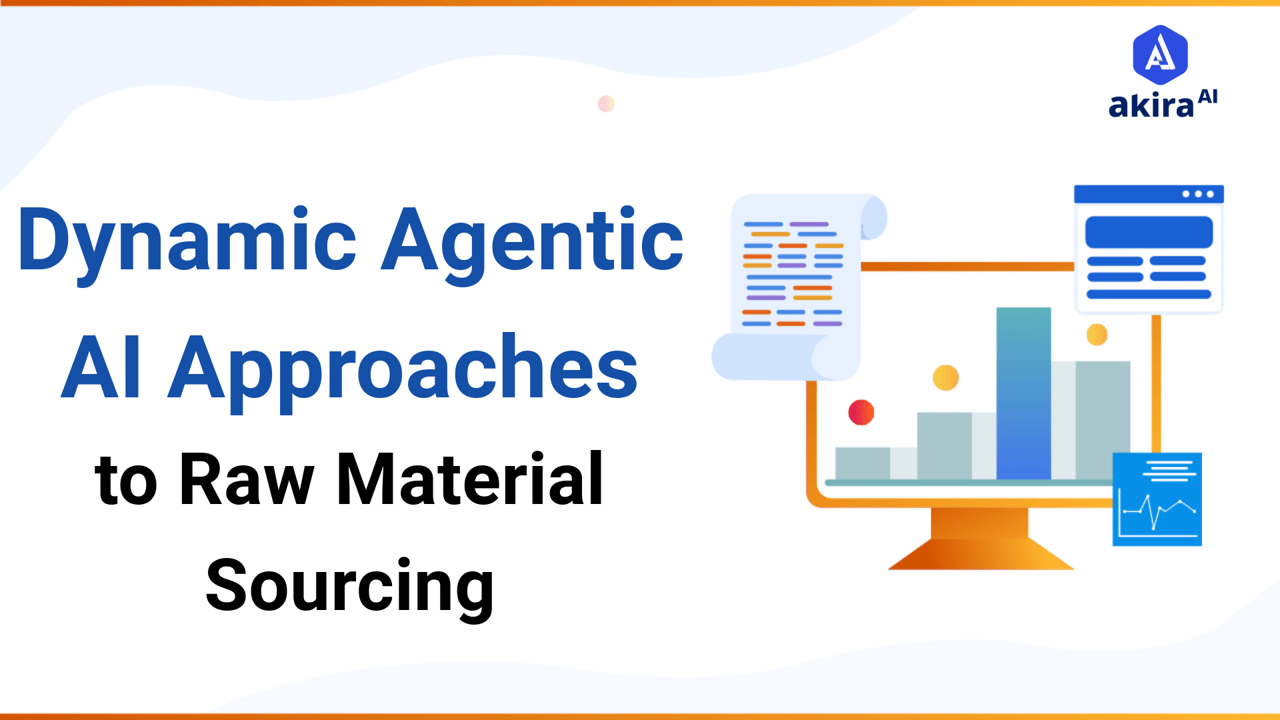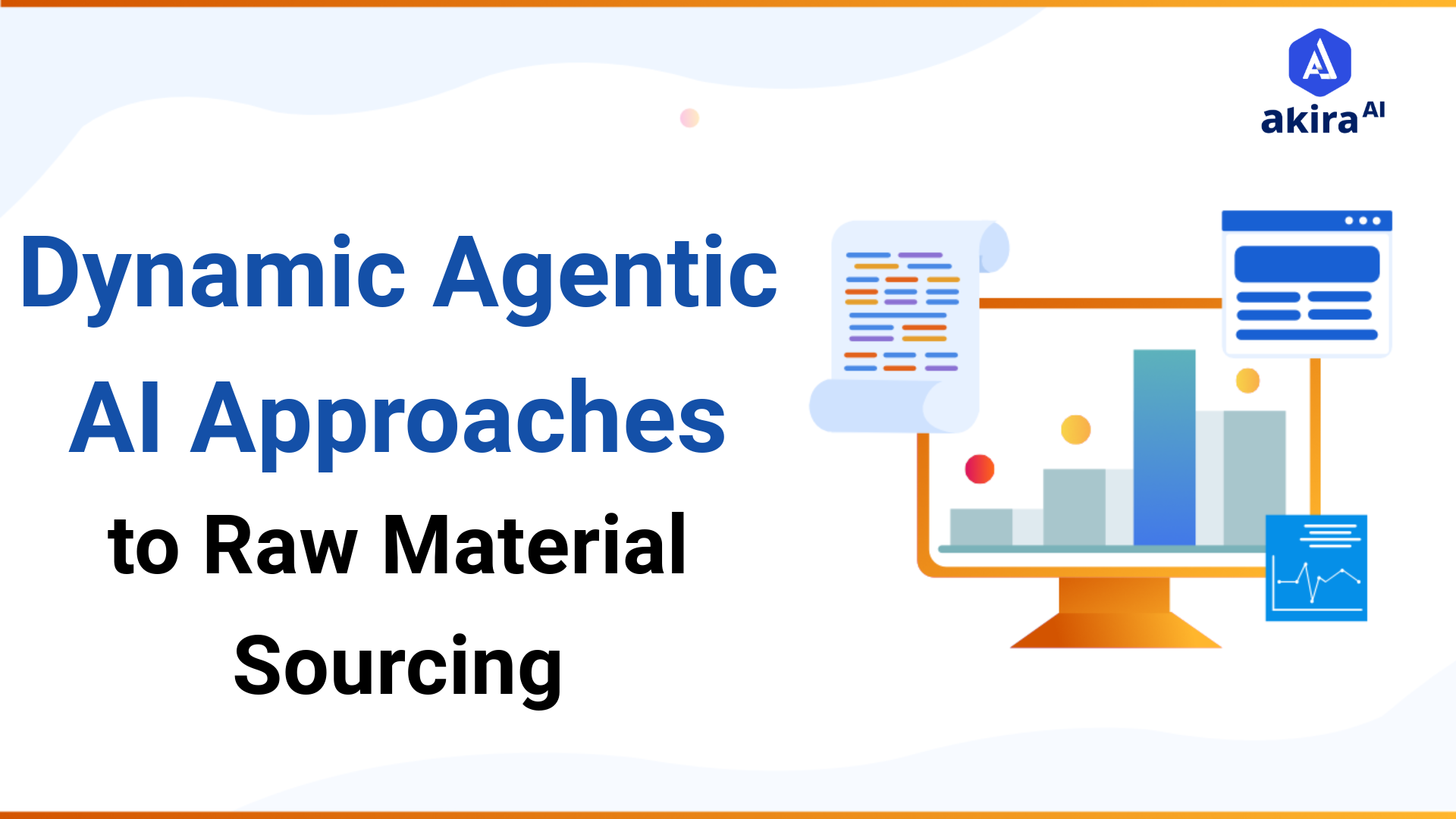Key Insights
Agentic AI is revolutionizing raw material sourcing by automating processes and enhancing decision-making through real-time data analysis. It improves market trend predictions and supplier evaluations, fostering greater efficiency and accuracy. The technology also supports sustainable sourcing practices, prioritizing environmental considerations. Overall, it equips organizations with the agility needed to excel in a competitive logistics landscape.

As the logistics landscape evolves, the integration of Agentic AI is redefining raw material sourcing strategies. No longer reliant on outdated methods, companies are harnessing intelligent algorithms to analyze data, predict trends, and optimize procurement processes. This shift not only enhances efficiency but also significantly reduces costs and waste. In an era where speed and precision are crucial, Agentic AI stands at the forefront, empowering organizations to make smarter, faster sourcing decisions. Join us as we explore the transformative impact of this technology on the logistics supply chain.
What is Raw Material Sourcing?
Raw material sourcing looks for finding, evaluating, and procuring the critical materials required for the production process. In logistics, this is highly crucial because it will either turn favorable or unfavorable toward production efficiency, management of cost, and thereby the quality of the product. Logistic organizations functioning in a competitive environment need to make use of strategically oriented approaches for material sourcing, ensuring conformity with the required standards for material and fulfillment of operative objectives.
A Brief Overview of Raw Material Sourcing in Logistics
The raw material sourcing challenges are characterized by volatile prices, supply chains, and sustainability practices in the logistics industry. Such a company would traditionally organize this process through manual ways, including suppliers' negotiations, assessment of the material itself in terms of quality, and constant monitoring of market trends. Such methods, though basic, are normally tedious and riddled with inaccuracies.
With the advent of digital technology and AI, raw material sourcing has undergone a significant transformation. AI agents can analyze vast amounts of data in real-time, identifying trends, predicting price fluctuations, and optimizing supplier selections. This shift not only streamlines the sourcing process but also enhances decision-making accuracy, allowing logistics companies to respond quickly to market changes and reduce operational risks.
Traditional vs Agentic AI Raw Material Sourcing
|
Aspect |
Traditional Sourcing |
Agent-Based Sourcing |
|
Market Research |
Manual data collection and analysis, time-consuming |
Automated market research using AI, real-time insights |
|
Supplier Evaluation |
Based on past relationships and limited data |
Comprehensive evaluation using big data and analytics |
|
Negotiation |
Time-consuming, manual negotiation processes |
Automated negotiation using historical data and trends |
|
Order Management |
Manual order placement and tracking |
Automated order management and real-time tracking |
|
Logistics Coordination |
Complex, often inefficient |
Optimized logistics using AI for route and cost optimization |
|
Quality Assurance |
Manual inspections, prone to errors |
Automated quality checks with machine learning |
|
Inventory Management |
Manual tracking, risk of overstock/stockouts |
Predictive inventory management using AI forecasting |
|
Risk Management |
Reactive approach to disruptions |
Proactive risk mitigation with AI-driven insights |
|
Compliance Monitoring |
Manual compliance checks |
Continuous compliance monitoring with AI agents |
How Do AI Agents Facilitate Raw Material Sourcing?
AI has the potential to revolutionize raw material sourcing by automating processes, improving accuracy, and providing real-time insights. AI agents can handle large volumes of data, make informed decisions, and optimize various aspects of the sourcing process.
-
Requirement Identification: The raw material sourcing process begins with a thorough needs assessment to identify the specific materials required for production. Through AI agents, we can analyze demand forecasts and inventory levels which keeps the sourcing aligned with production schedules and specifications.
-
Market Analysis: AI agents conduct comprehensive market analysis by gathering and analyzing data on supplier availability, pricing trends, and emerging opportunities. This automated process helps identify potential suppliers that meet the defined specifications, providing valuable insights for sourcing decisions.
-
Supplier Evaluation: AI agents rate the potential suppliers according to their pre-defined criteria such as quality, reliability, and cost. This is how AI agents rank a pool of suppliers and therefore recommend the best ones to source from.
-
Negotiation: During the negotiation phase, AI agents can assist in securing favorable terms with suppliers. They leverage historical data and market insights to propose optimal conditions, ensuring compliance with organizational policies before finalizing contracts.
-
Logistics Planning: Transport route planning and scheduling deliveries are calculated by AI Agents. Such tracking of logistics costs ensures not only the effectiveness of raw material transportation but also increased efficiency in the supply chain.
-
Reporting and Analysis: It aggregates data from all sourcing stages to generate detailed performance reports. They analyze sourcing efficiency, supplier performance, and market trends.
Use Case of AI Agents in Material Sourcing
-
Just-In-Time (JIT) Manufacturing: Automotive manufacturers require a consistent supply of high-quality raw materials, such as steel, plastics, and electronic components, to keep assembly lines running smoothly. AI agents can monitor supplier performance, predict demand, and manage inventory levels to ensure that raw materials are available exactly when needed.
-
Supply Chain Optimization: Electronic equipment manufacturers obtain raw materials from all over the globe, which can include rare earth metals, glass, and silicon. AI agents find the suppliers and track their performance; negotiate contracts with them, arrange logistics to procure materials properly on time.
-
Vaccine Production: Vaccine-manufacturing companies through partnering produce specific raw materials required for vaccine production. These include vials, and packaging materials. AI agents accurately predict the demand, monitor the quality of a supplier, ensure suppliers' regulatory standards, and optimize the logistics for critical material supplies in time.
-
Sustainable Sourcing: Food and beverage companies source raw materials such as cocoa, coffee beans, and dairy products are procured from diverse regions. AI agents analyze data on sustainable sourcing practices and review the supplier's sustainability credentials, optimize supply routes, and track environmental impact.
-
Diverse Product Lines: Manufacturers of consumer goods source a wide range of raw materials for various product lines, including personal care items, cleaning agents, and food products. AI agents forecast demand for different products, manage supplier relationships, ensure compliance with safety standards, and optimize logistics for multiple supply chains.
The Role of Akira AI’s Multi-Agent Platform in Raw Material
To automate the process of raw material procurement process, we can design a system comprising multiple AI agents, each specializing in various aspects of the sourcing process. At the core of this system will be a Master Orchestrator Agent that coordinates the activities of all other specialized agents.
-
Master Orchestrator Agent: The Master Orchestrator Agent coordinates all the agents involved in raw material procurement. It coordinates general sourcing with each other through such a process by delegating tasks to individual agents and helps in the smooth integration of their activities.
-
Market Research Agent: This market research agent scans and analyses market data looking for new suppliers and detecting trends in emerging markets. It looks for price fluctuation, identifies new suppliers, and general market conditions, among others.
This agent is responsible for developing strategic sourcing decisions that fit into the dynamics of the market while providing insightful and future-focused value to organizations.
-
Supplier Evaluation Agent: The supplier rating agent checks on the possible suppliers whether they meet the set criteria relating to quality and reliability. Bids together with proposals from the suppliers and their background checks are taken into consideration.
The rating and ranking of suppliers concerning their reliability, quality, and cost helps understand the best source that organizations require for raw material needs.
-
Negotiation Agent: The Negotiation Agent is responsible for ascertaining desirable conditions of relationship with suppliers. It deals with negotiations concerning terms of prices, delivery terms, and contracts by utilizing history and information from the current market to propose the best terms.
-
Logistics and Transportation Agent: The Logistics Agent optimizes the movement of raw materials by planning and scheduling transportation routes. It monitors shipment progress to ensure timely delivery and manages logistics costs to enhance efficiency.
Benefits of Using AI Agents in Raw Material Sourcing
Implementing AI agents in raw material sourcing offers several benefits:
-
Efficiency: Streamlines the sourcing process, reducing manual effort and time. AI agents automate various aspects of the raw material sourcing process, such as data collection, supplier evaluation, and order management. This automation significantly reduces the time and effort required for these tasks.
-
Cost Savings: Optimizes negotiations, logistics, and inventory management, leading to cost reductions. By leveraging historical data and market trends, AI-driven negotiation agents can secure the best terms and prices from suppliers, reducing procurement costs. Additionally, logistics optimization through AI minimizes shipping costs by planning the most efficient routes and schedules.
-
Accuracy: Improves accuracy in supplier evaluations, quality assurance, and inventory forecasting. AI agents enhance the precision of supplier evaluations by using comprehensive datasets and advanced analytics to assess supplier reliability, quality, and performance.
-
Scalability: Easily scales operations to handle increased sourcing needs as the business grows. AI agent systems are inherently scalable, meaning they can manage larger volumes of data and more suppliers without a significant increase in resource requirements.
-
Risk Mitigation: Enhances risk management by providing real-time insights and proactive measures. AI agents continuously monitor the supply chain for potential disruptions, such as geopolitical issues, natural disasters, or supplier insolvency. By providing real-time insights and predictive analytics, these agents enable companies to identify and address risks proactively.
-
Sustainability: The AI agents enforce sustainability by scanning the suppliers considering the environmental policies of the firm and selecting only the suppliers that strictly follow the standards for sustainability. The optimization of logistics reduces carbon emissions with efficient routes and minimum shipment.
Technologies Transforming Material sourcing
AI-driven sourcing relies on several technologies and frameworks.
-
AutoGen Framework: The AutoGen Framework is a powerful tool for enabling automated agent orchestration. It allows the creation of autonomous systems that can generate and manage multiple AI agents in real time.
-
Knowledge Graphs: Knowledge Graphs are a crucial technology that helps model relationships between different entities, such as customers, products, and supplies.
-
Reinforcement Learning: Reinforcement Learning (RL) is another key technology in sourcing, where agents learn optimal strategies through trial and error, receiving feedback based on their actions.
-
Data Lakehouse: Platforms like Snowflake integrate structured and unstructured data in a scalable environment, enabling agents to access large datasets in real time for inventory management. Data lake houses combine the best of data lakes and data warehouses.
-
Simulation and Optimization Software: Software like MATLAB allows organizations to simulate different sourcing scenarios and evaluate the impact of numerous factors on supply chain performance.
Future Trends in Raw Material Sourcing
The future of raw material sourcing will be shaped by several key trends:
-
Advanced Predictive Analytics: A multiagent system will leverage advanced predictive analytics to forecast demand and market trends. By tapping into various external data sources—such as government economic indicators, geopolitical events, and climate patterns—these systems can produce more accurate and actionable forecasts.
-
Improved Traceability: Technologies like Lang Smith and Swarm are enhancing transparency and traceability in raw material sourcing. This increased visibility fosters greater trust between suppliers and buyers, leading to more sustainable and ethical sourcing practices.
-
Sustainability and Ethical Sourcing: With sustainability becoming a key priority, innovative technologies are crucial for evaluating the environmental impact of sourcing decisions. This shift encourages circular sourcing, where raw materials are reused and recycled, effectively minimizing waste.
-
Hyper-Personalization in Supplier Selection: Organizations are increasingly focusing on personalized supplier selection processes. By assessing suppliers based on unique criteria—such as alignment with corporate values, innovation capabilities, and geographic factors—companies can tailor their sourcing strategies more effectively.
-
Decentralized Sourcing Models: The move towards decentralized sourcing models allows companies to source materials from multiple suppliers across various locations. This approach reduces reliance on single sources and is supported by agents that analyze local market conditions and logistical factors, enhancing resilience and flexibility in the supply chain.
Conclusion: AI Agent for Raw Material Sourcing
AI agents are fundamentally transforming raw material sourcing in logistics, offering unprecedented efficiency, accuracy, and optimization. By utilizing specialized AI agents coordinated by a Master Orchestrator Agent, companies can streamline their sourcing processes, minimize costs, and significantly enhance overall supply chain performance. As businesses increasingly adopt these intelligent systems, they gain a competitive edge in an ever-evolving marketplace, allowing for more responsive and adaptive sourcing strategies.
Looking ahead, the future of raw material sourcing is filled with opportunities for innovation and growth, particularly as AI technology continues to advance. As a result, the integration of AI agents in raw material sourcing will not only enhance operational efficiency but also drive long-term strategic advantages for organizations in the logistics sector.


